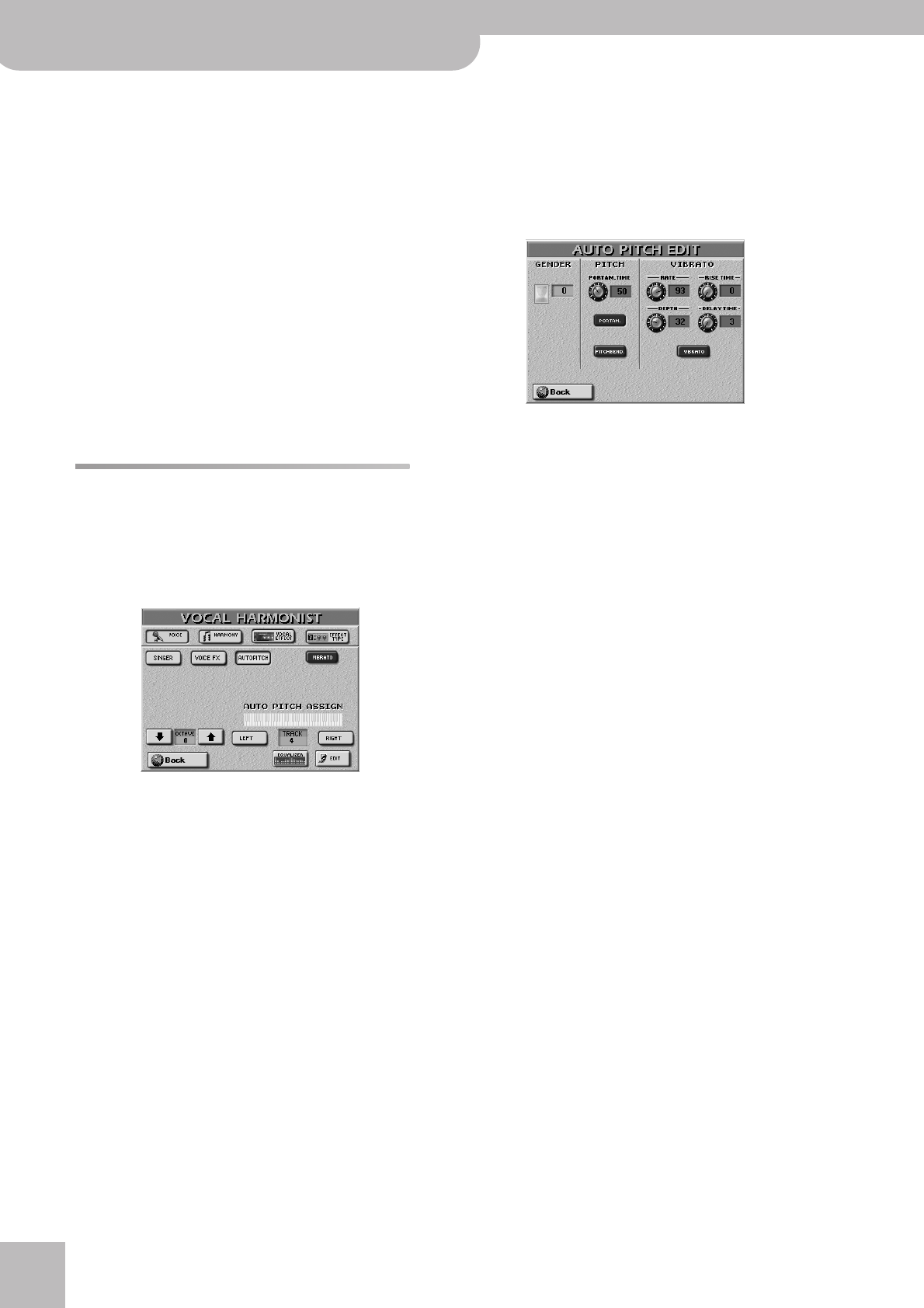
Editing the Vocal Harmonist parts
152
r
E-80 Music Workstation
● Vibrato RATE—Sets the speed of the vibrato effect.
● Vibrato DEPTH—Allows you to set the vibrato intensity.
Vibrato is an effect that changes (“modulates”) the pitch.
The higher the DEPTH value, the more outspoken these
periodic pitch changes will be.
● Vibrato RISE TIME—Allows you to set a swell for the
vibrato effect. This parameter specifies how long it takes
before the DEPTH value is reached – once the Delay Time
is up.
● Vibrato DELAY TIME—Allows you to set a delay between
the moment you start singing and the moment the
vibrato effect kicks in.
• Press the [Back] field to leave this page.
Note: If you select another preset, the Pitch and Vibrato
parameters on the EDIT page are reset to their factory values.
If you press the
[EQUALIZER]
field…
…the VOCAL EQUALIZER page appears. It contains a
simple equalizer for the Voice-FX, Auto Pitch and
Singer parts. See p. 151.
Auto Pitch settings
When the [AUTO¥PITCH] indicator lights, only the words
you say are used. The melody added to these words is
generated by the Vocal Harmonist. This is similar to the
Vocoder part, except that Auto Pitch is monophonic
(and thus meant as “solo voice”).
(1) Press and hold the [AUTO¥PITCH] button.
(2) Press the [VIBRATO] field to add an automatic
vibrato effect to the generated voice.
The Vibrato parameters can be set on the EDIT page.
● OCTAVE—If you are not happy with the register of the
generated voice, you can transpose it up or down by up
to 2 octaves.
(3) Set the desired “TRACK” value with the
[DATA÷ENTRY] dial or the [DEC]/[INC] buttons.
This is where you select the track that should supply
the note information for the melody to be generated.
In most instances “4” is a good choice, because that
track usually contains the melody. This only applies to
Standard MIDI Files you play back using the Recorder.
Note: Use the Minus One function to mute the selected track
if it should not be played alongside the generated vocal part.
See page 45 for details.
Press the [LEFT] and/or [RIGHT] field if you want to
use the melody you play on the keyboard. The
“divide” between LEFT and RIGHT follows the split
point setting (see p. 65).
(4) When you are done, either press the [EXIT] button
to return to the main page or one of the other
fields to set those parameters as well.
Note: The [VOCAL¥EFFECT] and [EQUALIZER] fields allow you
to jump to the effects or tone controls.
If you press the
[EDIT]
field…
…the display looks as follows:
• Press the field of the parameter you want to edit and
set the desired value with the [DATA÷ENTRY] dial or
the [DEC]/[INC] buttons.
Here’s what the parameters mean:
● GENDER—Allows you to change the timbre of the part.
Negative values produce a “masculine” effect, positive
values add “feminine” qualities. This parameter should be
set in relation to the COARSE value (if you want to
achieve a realistic effect).
● PORTAM TIME & [PORTAMENTO]—See page 49.
● PITCH BEND—Press this field (so that it “lights”) if you
want to influence the pitch of the voice effect using the
E-80’s Pitch Bend lever.
● Vibrato RATE, DEPTH, RISE TIME, DELAY TIME—These
are the same parameters as for the Voice-FX part. See
therefore page 152. This time, however, they apply to
the Auto Pitch part.
Note: The [VIBRATO] button icon must “light” for the
Vibrato effect to be noticeable.
• Press the [BACK] field to leave this page.
If you press the
[EQUALIZER]
field…
…the VOCAL EQUALIZER page appears. It contains a
simple equalizer for the Voice-FX, Auto Pitch and
Singer parts. See p. 151.
